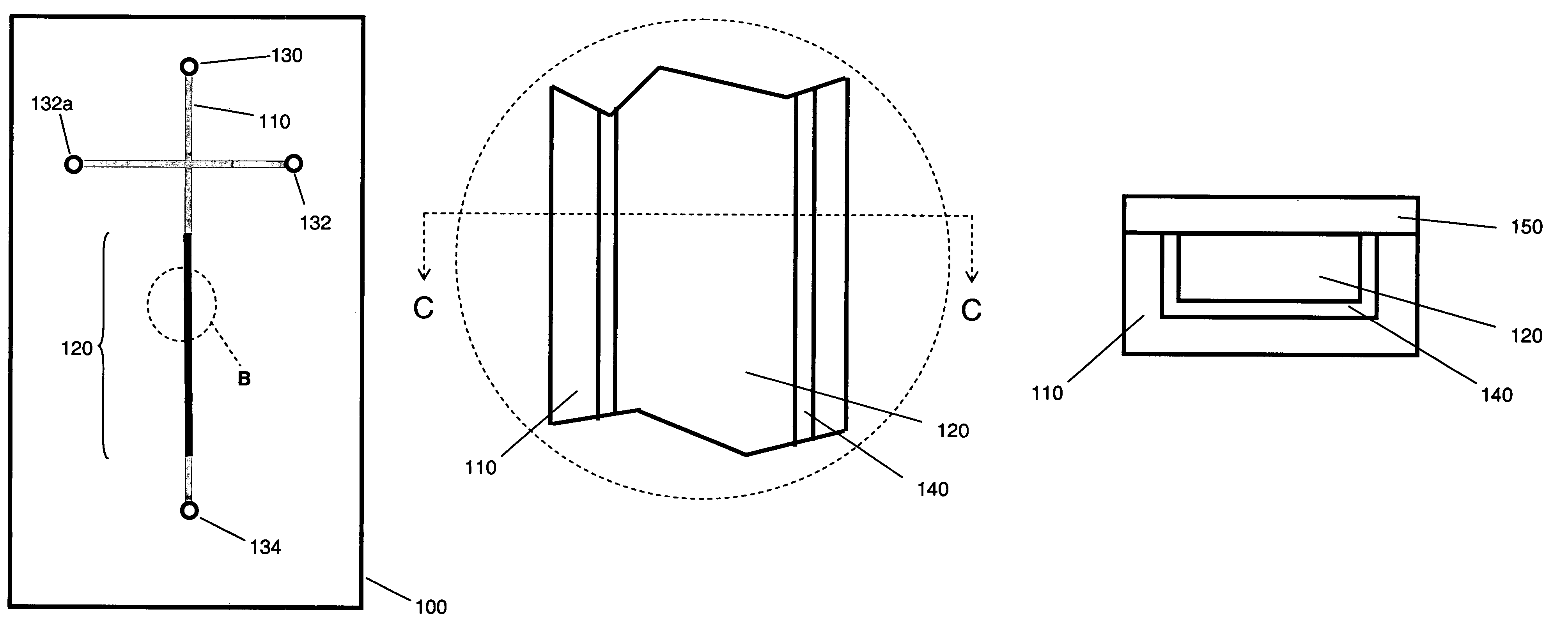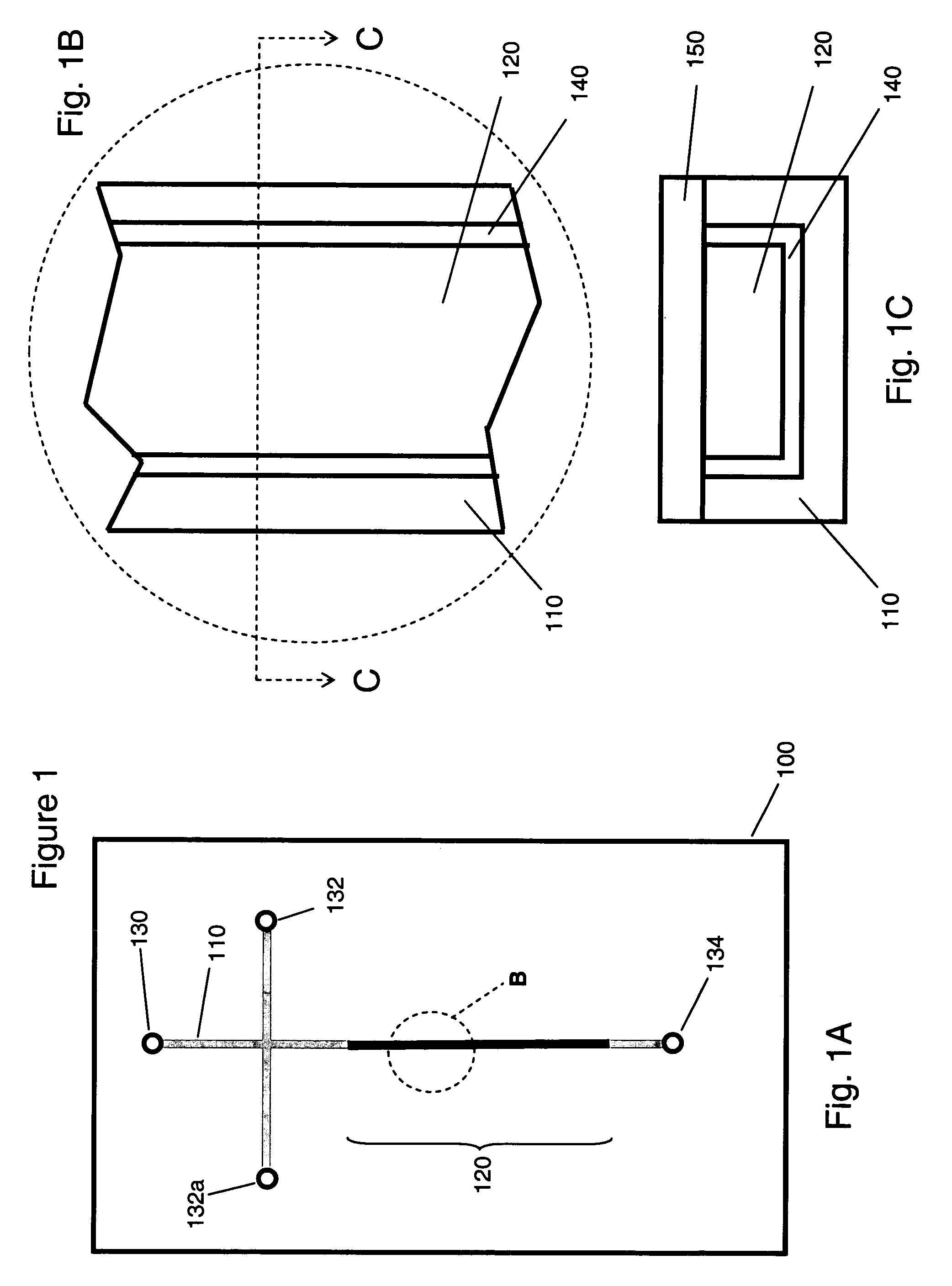Photoinitiated grafting of porous polymer monoliths and thermoplastic polymers for microfluidic devices
a technology of thermoplastic polymers and porous polymer monoliths, which is applied in the direction of liquid/fluent solid measurement, peptides, machines/engines, etc., can solve the problems of high cost of multi-step wet fabrication of these microfluidic chips, affecting both the adsorption of other molecules and the reliability of quantitative assays, and persisting problems, so as to prevent significant deterioration in the performance of the device and poor bonding
- Summary
- Abstract
- Description
- Claims
- Application Information
AI Technical Summary
Benefits of technology
Problems solved by technology
Method used
Image
Examples
example1
Screening and Photografting Suitable Thermoplastic Polymer Substrates
[0105]The gray shaded area in FIG. 4 represents the emission spectrum of the UV lamp used and the UV-spectra of polycarbonate (1), poly(methyl methacrylate) (2), polydimethylsiloxane (3), polystyrene (4), cyclic olefin copolymer (5), hydrogenated polystyrene (6), borofloat glass (7) and quartz (8). FIG. 4 shows that quartz (8) is transparent in the entire range, while polycarbonate (1) is completely opaque and therefore not suitable for photografting. The other polymer materials tested all exhibit some transparency within this acceptable range of wavelength between 230-330 nm.
[0106]Among the synthetic polymers, PDMS exhibits the best transparency in the deep UV range. However, its very low Tg makes this material suitable only for limited range of applications such as rapid prototyping. PS-H is also sufficiently transparent and enables acceptable grafting. The UV transparency of COC, a commercially available enginee...
example 2
Monomer Mixtures for Photografting
[0111]The compositions of the acrylamide reaction mixtures used for grafting according to Example 1 are summarized in Table 1. The surfactant PLURONIC F-68 was added to aqueous systems to improve the solubility of benzophenone. All mixtures were deoxygenated by purging with nitrogen for 10 min prior to photografting. Mixtures A, B, C, D, E and F represent different compositions. Mixtures E and F represent the preferred composition of reaction mixture for photografting in the following examples. “BP wt %” indicates the amount of benzophenone used to initiate polymerization.
[0112]
TABLE 1Reaction mixtures used for photograftingReactionAcrylamideBPPluronic F-68mixturewt %wt %wt %SolventAbulk3.00NoneB300.670.67H2OC300.330.33H2OD150.330.33H2OE150.220tBuOH—H2O 3:1F150.220tBuOH
example 3
Photografting Efficiencies and Contact Angles of Acrylamide on Various Substrate
[0113]Photografting of acrylamide on COC using various polymers as filters was performed according to Example 1. Table 2 summarizes the results obtained after 2 min of grafting. Acrylamide was chosen since it contains nitrogen atoms, not present in COC and therefore useful in characterization. In addition, its grafting also changes the polarity of the original hydrophobic surface enabling further measurements for the purpose of characterization.
[0114]
TABLE 2Photografting of acrylamide on COC using various polymers as a filterIrradiation power,mW / cm2a2 min irradiationFilter260 nm310 nmNeffbContact angleQuartz12.512.10.7945Borofloat glass5.89.50.7360PS2.15.60.6261PS-H4.76.80.6755COC7.99.60.7948PDMS6.18.70.7154PMMA0.40.10.3960PC000c 85caTwo probe heads (260 and 310 nm) cover the range between 220 nm and 340 nm shown in FIG. 4.bGrafting efficiency calculated from atomic ratios determined by XPS (N / C found)...
PUM
| Property | Measurement | Unit |
|---|---|---|
| wavelength range | aaaaa | aaaaa |
| thickness | aaaaa | aaaaa |
| wavelength range | aaaaa | aaaaa |
Abstract
Description
Claims
Application Information
 Login to View More
Login to View More - R&D
- Intellectual Property
- Life Sciences
- Materials
- Tech Scout
- Unparalleled Data Quality
- Higher Quality Content
- 60% Fewer Hallucinations
Browse by: Latest US Patents, China's latest patents, Technical Efficacy Thesaurus, Application Domain, Technology Topic, Popular Technical Reports.
© 2025 PatSnap. All rights reserved.Legal|Privacy policy|Modern Slavery Act Transparency Statement|Sitemap|About US| Contact US: help@patsnap.com



